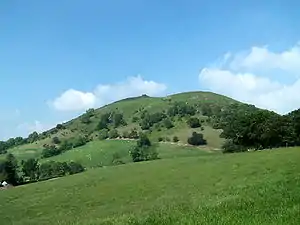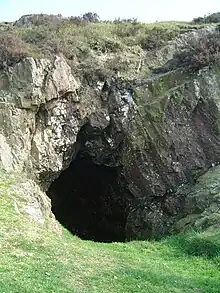Caer Caradoc
Caer Caradoc (Welsh: Caer Caradog, the fort of Caradog) is a hill in the English county of Shropshire.[1] It overlooks the town of Church Stretton and the village of All Stretton and offers panoramic views to the north towards the Wrekin, east to Wenlock Edge, and west over the nearby Long Mynd. It is not to be confused with another hillfort of the same name 1 km west of Chapel Lawn near Bucknell.[2]
| Caer Caradoc Hill | |
|---|---|
 Caer Caradoc | |
| Highest point | |
| Elevation | 1,506 ft (459 m) |
| Prominence | 889 ft (271 m) |
| Listing | Marilyn |
| Naming | |
| Native name | Caer Caradog (Welsh) |
| Geography | |
| Location | Shropshire, England |
| Parent range | Shropshire Hills |
| OS grid | SO477953 |
| Topo map | OS Landranger 137, 138 |

Caer Caradoc rises sharply out of a narrow valley known as the Stretton Gap. It is the highest point on a high, narrow, northeast–southwest "whaleback ridge", sometimes called a hogsback ridge. The Wrekin is a very similarly shaped hill and on the same alignment, some 10 miles (16 km) to the north-east. Caer Caradoc can be fairly easily climbed from Church Stretton but the ascent/descent is steep; a more gentle climb is from the village of Cardington, which lies two miles (3 km) east.
Much of the hill is composed from volcanic rocks, like the Wrekin and other hills, formed of narrow ridges of resistant Precambrian rock thrust upwards by movements deep down along the Church Stretton Fault. This fault line runs from Staffordshire in England to Pembrokeshire in Wales and can be seen on Ordnance Survey maps as a line of springs on this hill.[3]

The summit has an Ancient British Iron Age[1] or late Bronze Age hill fort. It is this which the hill is named after – Caer Caradog in Welsh meaning Caradog's fort. Local legend has it that this was the site of Caratacus's last battle against the Roman legions during the Roman conquest of Britain, and that after the battle he hid in the cave near its summit. However, there is no river nearby and Tacitus refers to a river in his description of the site.[4][5]
References
- Historic England. "Caer Caradoc large multivallate hillfort, associated causeway and Caractacus' Cave on the summit of Caer Caradoc Hill (1010723)". National Heritage List for England. Retrieved 13 April 2018.
- Historic England. "Caer Caradoc: a small multivallate hillfort (1021067)". National Heritage List for England. Retrieved 13 April 2018.
- "Church Stretton fault". Shropshire Geoplogy. Retrieved 8 April 2022.
- "Ancient Worlds - The legend of Caractacus". Archived from the original on 22 August 2021.
- Tacitus. Annals 12:33-38.